Answered step by step
Verified Expert Solution
Question
1 Approved Answer
Because most of the parts for Waterways drainage and irrigation systems are standard, the company uses a process cost system for most of its manufacturing.
Because most of the parts for Waterways drainage and irrigation systems are standard, the company uses a process cost system for most of its manufacturing. Its recent contract to upgrade the cityowned soccer fields has increased the demand for a specific type of maintenancefree piping and the new joints and coupling units that make the systems so flexible.The parts go through three separate processes: moulding, cutting, and welding. They are then transferred to raw materials inventory, where they are available to the installation units for use in the field.The following information is available for the processing of the piping in the moulding department for the month of July. One metre of piping is considered to be one unit.Beginning work in process inventory:Units in processStage of completion for direct materialsStage of completion for direct labour and overheadCosts in work in process inventoryDirect materials$Direct labourOverhead$Units started into production in JulyUnits completed and transferred out in JulyCosts added to production during July:Direct materials$Direct labourOverhead$Ending work in process inventory:Units in processStage of completion for direct materialsStage of completion for direct labour and overheadInstructionsUsing the weightedaverage method, prepare a production cost report for Waterways for the moulding department for the month of July.Show the equivalent units of production for direct materials and conversion costs if Waterways used the FIFO method instead of weightedaverage.Notes This item was originally published by the Certified General Accountants Association of Canada CGA Canada as an examination question. Adapted with permission of the Chartered Professional Accountants of Canada, Toronto, Canada. Any changes to the original material are the sole responsibility of the publisher and have not been reviewed or endorsed by the Chartered Professional Accountants of Canada This item was originally published by the Society of Management Accountants of Canada CMA Canada as an examination question. Adapted with permission of the Chartered Professional Accountants of Canada, Toronto, Canada. Any changes to the original material are the sole responsibility of the publisher and have not been reviewed or endorsed by the Chartered Professional Accountants of Canada This item was originally published by the Society of Management Accountants of Canada CMA Canada as an examination question. Adapted with permission of the Chartered Professional Accountants of Canada, Toronto, Canada. Any changes to the original material are the sole responsibility of the publisher and have not been reviewed or endorsed by the Chartered Professional Accountants of Canada This item was originally published by the Certified General Accountants Association of Canada CGA Canada as an examination question. Adapted with permission of the Chartered Professional Accountants of Canada, Toronto, Canada. Any changes to the original material are the sole responsibility of the publisher and have not been reviewed or endorsed by the Chartered Professional Accountants of Canada This item was originally published by the Certified General Accountants Association of Canada CGA Canada as an examination question. Adapted with permission of the Chartered Professional Accountants of Canada, Toronto, Canada. Any changes to the original material are the sole responsibility of the publisher and have not been reviewed or endorsed by the Chartered Professional Accountants of Canada This item was originally published by the Society of Management Accountants of Canada CMA Canada as an examination question. Adapted with permission of the Chartered Professional Accountants of Canada, Toronto, Canada. Any changes to the original material are the sole responsibility of the publisher and have not been reviewed or endorsed by the Chartered Professional Accountants of Canada This item was originally published by the Society of Management Accountants of Canada CMA Canada as an examination question. Adapted with permission of the Chartered Professional Accountants of Canada, Toronto, Canada. Any changes to the original material are the sole responsibility of the publisher and have not been reviewed or endorsed by the Chartered Professional Accountants of Canada This item was originally published by the Certified General Accountants Association of Canada CGA Canada as an examination question. Adapted with permission of the Chartered Professional Accountants of Canada, Toronto, Canada. Any changes to the original material are the sole responsibility of the publisher and have not been reviewed or endorsed by the Chartered Professional Accountants of Canada.
Step by Step Solution
There are 3 Steps involved in it
Step: 1

Get Instant Access to Expert-Tailored Solutions
See step-by-step solutions with expert insights and AI powered tools for academic success
Step: 2

Step: 3

Ace Your Homework with AI
Get the answers you need in no time with our AI-driven, step-by-step assistance
Get Started


